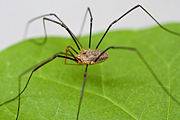Poison is toxic if you touch, eat, drink or breathe it, depending on what kind it is or form (plant, animal, food, gas, drink, etc.) it comes in. Certain mushrooms, poison ivy and oak, poison-dart frogs (in the wild), arsenic, hemlock, helium gas (in very large quantities or over long periods of exposure) are all poisonous. Venom, however, must be delivered into your blood stream to be toxic. Spiders, all except one, are venomous. For a venomous spider to affect a human it must inject its venom through its fangs into your skin.  The above picture is a Daddy long-legs spider. He is venomous, however, his venom is not toxic to humans …even if he could get into your bloodstream, so he is not classified as a venomous spider. The only exception to that would be if you were allergic to spiders in general, and not many people are.
The above picture is a Daddy long-legs spider. He is venomous, however, his venom is not toxic to humans …even if he could get into your bloodstream, so he is not classified as a venomous spider. The only exception to that would be if you were allergic to spiders in general, and not many people are.  . The above picture is the Granddaddy long-legs (also known as Harvestman). He is not a spider at all. He is an arachnid, which is the group spiders belong to. But scorpions, mites, ticks and others are all in the group, arachnids, and none of them are spiders either. The Harvestman, as I like to call them, is not only not a spider, but he has no venom, no venom glands or sacs and no fangs whatsoever. The Black widow, on the other hand, has a highly toxic venom. It is the fact that she is only about the size (or diameter) of a nickel or quarter that makes her less dangerous than some rattlesnakes. If the Black widow spider was the size of a Prairie rattlesnake, her bite would be 15 times as deadly as it is. Being that much larger, she would be able to inject more of her venom into you. Sometimes rumors get spread that one spider is more venomous (or has more toxic venom) than another because one is witnessed eating the other spider in its web. But the toxicity of spider venom to other spiders and insects is very different than with humans, and often other animals as well. Just because one spider may be venomous enough to kill another spider, even one like the black widow (or red back, if you live in Australia), doesn't mean its venom is any more toxic to humans. Venom toxicity often varies between species. For instance, the Sidney funnel-web spider is highly toxic to humans, but would not even make your cat or dog sick. Spiders' venom which wouldn't even affect humans at all, can kill other spiders and insects, even small rodents and lizards, in some cases.
. The above picture is the Granddaddy long-legs (also known as Harvestman). He is not a spider at all. He is an arachnid, which is the group spiders belong to. But scorpions, mites, ticks and others are all in the group, arachnids, and none of them are spiders either. The Harvestman, as I like to call them, is not only not a spider, but he has no venom, no venom glands or sacs and no fangs whatsoever. The Black widow, on the other hand, has a highly toxic venom. It is the fact that she is only about the size (or diameter) of a nickel or quarter that makes her less dangerous than some rattlesnakes. If the Black widow spider was the size of a Prairie rattlesnake, her bite would be 15 times as deadly as it is. Being that much larger, she would be able to inject more of her venom into you. Sometimes rumors get spread that one spider is more venomous (or has more toxic venom) than another because one is witnessed eating the other spider in its web. But the toxicity of spider venom to other spiders and insects is very different than with humans, and often other animals as well. Just because one spider may be venomous enough to kill another spider, even one like the black widow (or red back, if you live in Australia), doesn't mean its venom is any more toxic to humans. Venom toxicity often varies between species. For instance, the Sidney funnel-web spider is highly toxic to humans, but would not even make your cat or dog sick. Spiders' venom which wouldn't even affect humans at all, can kill other spiders and insects, even small rodents and lizards, in some cases.

